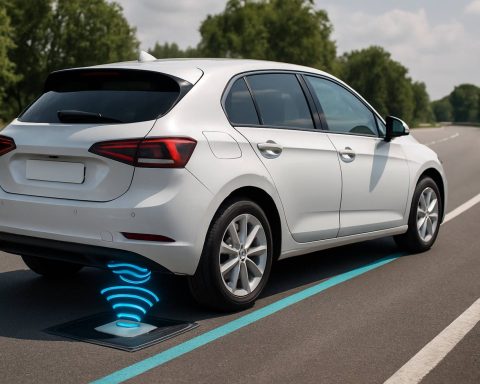- Rivian Automotive faced a challenging first quarter of 2025 with a significant drop in vehicle deliveries from 14,183 to 8,640, despite an increase in production numbers.
- The drop in deliveries was mainly due to a strategic reduction in electric van deliveries to Amazon following a previous expansion of their fleet.
- Rivian remains confident, maintaining its annual delivery target of 46,000 to 51,000 vehicles.
- Following the delivery report, Rivian’s stock fell nearly 2.8%, reflecting investor concerns amid broader market volatility.
- Anticipation builds for Rivian’s first-quarter financial results set to be disclosed on May 6, as stakeholders seek insight into future strategies.
- Rivian’s journey underscores the importance of resilience and adaptability in the pursuit of sustainable growth within the electric vehicle market.
Rivian Automotive, the ambitious player in the world of electric vehicles, has hit a speed bump. Although the company maintains a sunny outlook for the year, the first quarter of 2025 hasn’t been as electrifying as hoped. The American electric vehicle maker, headquartered in Normal, Illinois, saw its deliveries drop dramatically from the previous quarter—from 14,183 vehicles to 8,640. This sizeable dip contrasts with an uptick in production, where Rivian manufactured 14,611 vehicles, surpassing the fourth quarter’s 12,727 units.
Behind these numbers lies a terrain filled with logistical challenges and strategic shifts. One key reason behind the decline was a strategic reduction in the delivery of electric vans to one of Rivian’s major clients, Amazon. The e-commerce giant saw a substantial fleet expansion late last year, which Rivian has since dialed back as part of its recalibrated strategy.
Amid these fluctuations, Rivian reassures stakeholders that it remains on course to meet its ambitious annual delivery targets, projecting between 46,000 and 51,000 vehicles. The company’s confidence signifies a readiness to tackle barriers head-on, maintaining enthusiasm about its market trajectory and the innovative edge of its products.
Yet, the stock market tells a different story. Following the delivery report, Rivian’s stock dipped almost 2.8% to $11.21 per share. Investors appeared unsettled, mirroring broader market volatility heightened by tariffs-induced selloffs. Despite this, Rivian continues to forge its path in the competitive landscape, eyeing long-term gains over short-term stutters.
As May 6 approaches, when Rivian is set to reveal its financial results for the first quarter, speculation abounds. Market watchers and environmental enthusiasts alike await the details, hoping for clarity on how Rivian plans to marry its robust production capabilities with consumer demand amid a shifting economic backdrop.
In the face of challenges, Rivian’s story is one of resilience and adaptability. It serves as a reminder that the journey to revolutionizing transportation and achieving sustainable growth is rarely linear, demanding not just innovation, but also the flexibility to pivot when the road gets rough.
Rivian’s Rollercoaster: Can the Electric Vehicle Pioneer Spark a Turnaround?
Understanding Rivian’s Recent Performance
Rivian Automotive, the promising name in the burgeoning electric vehicle (EV) scene, is currently navigating through a challenging phase. Known for its innovative electric trucks and SUVs, Rivian has seen a decline in deliveries from 14,183 vehicles in the last quarter of 2024 to 8,640 in the first quarter of 2025. This dip contrasts with an increase in production, where Rivian manufactured 14,611 vehicles, an improvement from the previous quarter’s 12,727 units.
Factors Influencing the Decline
Amazon Partnership Reevaluation
One significant factor contributing to Rivian’s delivery downturn is a strategic adjustment in its contract with Amazon. Initially, there was a surge in deliveries to Amazon for its electric delivery vans. However, Rivian has recalibrated this partnership, which resulted in reduced numbers for early 2025.
Logistical Challenges
Rivian continues to encounter logistical challenges within the supply chain and distribution processes. These systemic issues are indicative of broader industry hurdles that many EV manufacturers face.
Prospects and Market Position
Despite the recent setbacks, Rivian remains optimistic about achieving its yearly delivery goals, projecting between 46,000 and 51,000 vehicles. This confidence stems from the company’s robust production capabilities and its commitment to innovation in the EV space.
Stock Market Reaction
Following the lackluster delivery report, Rivian’s stock fell by 2.8%, closing at $11.21 per share. This market reaction is a testament to investor concerns amid economic uncertainties and tariffs-induced selloffs.
Key Industry Insights
Long-term Growth Potential
Experts believe that the long-term outlook for Rivian is positive. The global EV market continues to expand as consumers and businesses increasingly adopt sustainable transportation solutions.
Competitive Landscape
Rivian’s primary competitors include established automotive giants such as Tesla, Ford, and GM, as well as emerging players like Lucid Motors. Maintaining a competitive edge will require Rivian to focus on scaling its operations and enhancing customer experiences.
Sustainability and Innovation
Rivian’s commitment to sustainability and cutting-edge technology positions it favorably in an industry that values environmental consciousness and innovation. The company’s emphasis on electric trucks and SUVs aligns with growing consumer demand for versatile, eco-friendly vehicles.
Exploring the Future
Challenges and Opportunities
Rivian’s journey is marked by both opportunities and challenges. As the company adjusts its strategies and addresses logistical bottlenecks, its ability to adapt and innovate will be crucial for sustained growth.
Market Forecast and Trends
The electric vehicle market is expected to grow exponentially over the next decade. According to industry forecasts, global EV sales could reach 30% of total vehicle sales by 2030.
Actionable Recommendations
1. Enhance Supply Chain Efficiency: Rivian should focus on optimizing its supply chain to prevent logistical delays and improve delivery rates.
2. Strengthen Investor Relations: Transparent communication regarding strategic changes and performance metrics can help rebuild investor confidence.
3. Diversify Partnerships: Beyond Amazon, Rivian should explore additional partnerships to expand its market reach and stabilize delivery demands.
4. Technology Advancements: Ongoing investment in battery technology and charging infrastructure will reinforce Rivian’s leadership in innovation.
Final Thoughts
Rivian’s current hurdles underscore the complexities of scaling in a rapidly evolving industry. By remaining flexible and committed to excellence, Rivian not only exemplifies resilience but also holds the potential to thrive as a leader in the electric vehicle market. For more insights on electric vehicles and sustainable transportation, visit Rivian.
Quick Tips for Consumers
– Explore Rivian Models: Check out the latest Rivian trucks and SUVs to experience advanced EV technology firsthand.
– Consider Long-term Savings: EVs often offer lower operating costs over time due to fuel savings and maintenance efficiencies.
– Stay Informed: Keep track of EV market trends and innovations to make informed purchasing decisions.









